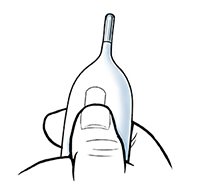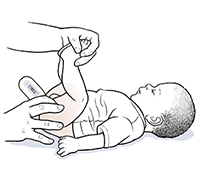Discharge Instructions: Taking a Rectal Temperature (Pediatric)
Discharge Instructions: Taking a Rectal Temperature (Pediatric)
You take a rectal temperature by placing a thermometer in your baby’s bottom. This method is more accurate than most other methods. But do this only when instructed by your baby’s healthcare provider. Use the steps on this sheet as a guide.
For infants and toddlers, be sure to use a rectal thermometer correctly. A rectal thermometer may accidentally poke a hole in (perforate) the rectum. It may also pass on germs from the stool. Always follow the product maker’s directions for proper use. If you don’t feel comfortable taking a rectal temperature, use another method. When you talk to your child’s healthcare provider, tell him or her which method you used to take your child’s temperature.
Get the thermometer ready
Be sure to use a digital thermometer that is specifically designed for rectal use.
Remove the cover from the thermometer.
Wash the thermometer with warm soapy water; then rinse with clear water.
Wipe the thermometer dry or let it air dry.
Smear a bit of petroleum jelly or water-based lubricant on the tip.
Find a comfortable position for holding your baby
Put your baby on his or her back on a firm surface. Hold the baby’s ankles and lift both legs, as if changing a diaper.
Or
Place your baby face down across your lap.
Then
Use one hand to part the baby’s buttocks.
Take the temperature
Follow the specific directions for using your digital thermometer.
Gently slip the tip of the thermometer into the opening where bowel movements leave baby’s body (the rectum) no farther than ½ inch to 1 inch.
Hold the thermometer in place until it beeps.
Slide the thermometer out. Read the temperature on the digital display. Normal rectal temperature is about 97.6°F (36.4°C) to 100.2°F (37.9°C).
Before putting the thermometer away, clean it with soap and warm water.
Follow-up care
Follow up with your child’s healthcare provider, or as advised.
When to seek medical care
Call your child's healthcare provider right away if your child has any of the following:
Bleeding from the area where you took the temperature
Fever (see Fever and children, below)
Your child has had a seizure
Your child seems very ill, is listless, or is acting very fussy
Fever and children
Always use a digital thermometer to check your child’s temperature. Never use a mercury thermometer.
Here are guidelines for fever temperature. Ear temperatures aren’t accurate before 6 months of age. Don’t take an oral temperature until your child is at least 4 years old.
Infant under 3 months old:
Ask your child’s healthcare provider how you should take the temperature.
Rectal or forehead temperature of 100.4°F (38°C) or higher, or as directed by the provider
Armpit temperature of 99°F (37.2°C) or higher, or as directed by the provider
Child age 3 to 36 months:
Rectal, forehead, or ear temperature of 102°F (38.9°C) or higher, or as directed by the provider
Armpit temperature of 101°F (38.3°C) or higher, or as directed by the provider
Child of any age:
Repeated temperature of 104°F (40°C) or higher, or as directed by the provider
Fever that lasts more than 24 hours in a child under 2 years old. Or a fever that lasts for 3 days in a child 2 years or older.
Updated:
March 28, 2018
Reviewed By:
Freeborn, Donna, PhD, CNM, FNP,Image reviewed by StayWell medical illustration team.,Lee, Kimberly G., MD, MSc, IBCLC,Turley, Ray, BSN, MSN

